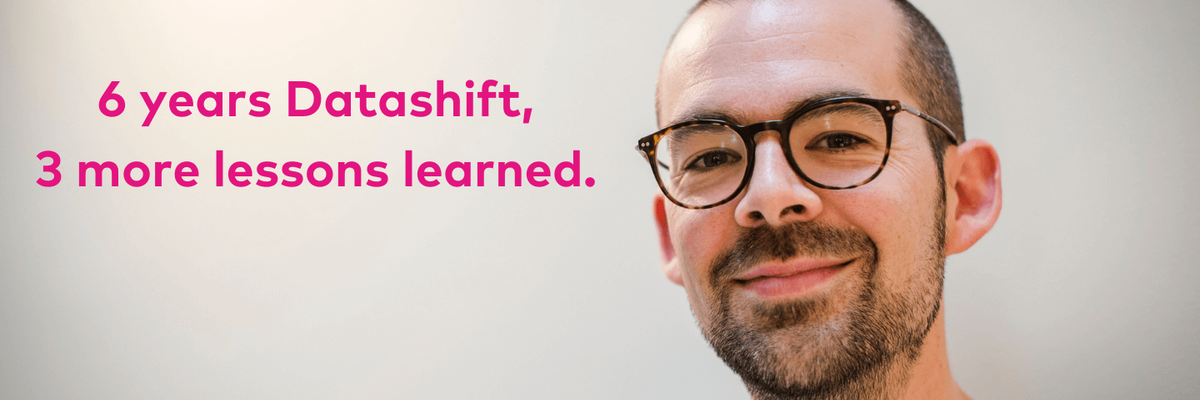Upon general request: six years of Datashift, three more lessons learned.
24 February 2021

Two weeks ago, we posted a blog article about the three lessons we’ve learned in the past six years of Datashift. We received such great responses to our list of “don’ts,” I decided to share with you a list of three “do’s.” So, back by popular demand, here are another three important lessons six years of Datashift have taught us.
1. Do listen to your customers (but really listen)
It seems like an obvious one. ‘Of course, we listen to our customers!’. Yes, but do you really? Do you actually hear them and understand them? You can only know their real needs and why these needs haven’t been answered yet by listening carefully. Walk a mile in your customer’s shoes. Look at the entire picture of the company, not just at what they ask you.
Many companies understand that being data-driven is the new ‘next big thing,’ so they hunt for new technologies to help them in that quest. But technology is not always the right - or the only - answer. For example: one of our clients first contacted us for creating a new set of insights and dashboards. They were struggling with managing customer churn. When diving deeper into the context and situation, our team quickly understood that new dashboards weren’t the solution in the short term. The company already had more than enough insights. The underlying issue? There was no unanimity on how to measure churn. So we started the assignment by making the definitions more clear, which was accepted by all stakeholders. Later on, we simply adapted existing dashboards. Result: less investment for client + happy client. And guess what: they immediately asked us to take on two additional challenges they’re dealing with as well!
The lesson learned? What companies initially demand is not always what they actually need.
They rarely need just technical expertise, but more often than not also business insights. And at Datashift, we have no problem telling our customers what’s what. We’re honest with them when we realize that what they need is something we can’t give them, or if we think they need to get other things in order first. We want what’s best for them, so we would never accept a project where we feel we couldn’t help in the right way or couldn’t make enough impact.
2. Do treat people differently
This one is a little less obvious, right? We’re taught to treat everybody equally, but in these six years of Datashift, I’ve learned that this idea wouldn’t bring us very far. The opposite is true. Differentiating is good and fair. If you want everyone to be treated fairly, you need to differentiate.
We have a great mix of employees at Datashift, but every single one of them is their own person with their own traits, skills, stress triggers.
If I would give everyone the same training, the same treatment, the same customers - then I would never get any of our team members to their ‘sweet spot’.
It would be like settling for “average”. And at Datashift, we don’t settle for average 😊
It’s essential for a company to look at what every person needs to fulfill their role, respond to the job demands without too much stress, evolve, get better and better, and reach individual ambitions.
3. Do combine facts with gut feeling
Facts are great; facts are necessary. But they’re not the only thing to take into account when you’re making a decision. You can be rational about everything in business but still make the wrong decision. In the six years of Datashift, we’ve learned to combine the rational with our intuition. If you’d only follow the facts - your revenue, your customer growth, a potential employee’s resumé - then you’re just managing an Excel file. You lose touch with your company’s culture and vision very quickly. On the other hand, it’s a bad idea only to follow your gut as a business leader because you’d end up in an ivory tower alone. You need feedback; you need to talk with others, listen to reason.
These past six years we’ve hired a few people that might not look like the best fit for Datashift on paper. Their resumé was absolutely fine and they had great skills, but not all the ones we expect a Datashift employee to have. Yet, I had such a strong feeling about them. There was something about these people that made me think they would be great for Datashift in the long run. So I followed my gut, backed by the fact that their resumé showed other useful skills, and I hired them. Looking back, these were all right decisions. If I had only followed the fact that they weren’t the type of employee we needed, Datashift would’ve missed out on some great people.
If someone at Datashift has a gut feeling - good or bad - about a project, decision, or trajectory, we take it seriously.
We encourage everyone to lay it all out in the open and talk about why they think something might not be a good idea or if there’s a better way to go about something. Always with the utmost respect and maturity. We discuss it, think about it, but never just cast someone’s gut feeling aside. That’s only possible if you, as a leader, create an environment where people can think along with you, understand the company’s vision, and agree that everyone should be heard. Put some effort into such an environment, and it’ll pay off in the long run.
